UPDATE: Thanks to the answer below I managed to get this to work on Windows 7. I have since realized that Windows 10 installs but overrides my driver with the OEM USB Serial driver. Please see: Trouble installing custom inf in Windows 10 Professional. Windows overrides it with OEM driver
-
I attempted to make an Inf file that installs a usb-serial device using the standard windows usb-serial driver. This file successfully installs the driver on Windows 8.1 and Windows 10 but fails in Windows 7 32bit and Windows 7 64 bit. I attempted to right-click install the driver from the desktop (default install). The first time I attempted this I was presented with the error "The inf file you suggested does not support this method of installation". I added the defaultInstall sections to the inf file. After I did this the error disappeared but the system could not find usbser.sys. "The file 'usbser.sys' on windows cd is needed."
What do I need to add to the inf file below in order to make this successfully install from Windows 7?
Current inf file:
;************************************************************
; Windows USB CDC ACM Setup File
; Copyright (c) 2000 Microsoft Corporation
; Version v1.1, updated 17 April 2013
[Version]
Signature="$Windows NT$"
Class=Ports
ClassGuid={4D36E978-E325-11CE-BFC1-08002BE10318}
Provider=%MFGNAME%
LayoutFile=layout.inf
CatalogFile=%MFGFILENAME%.cat
DriverVer=11/15/2007,5.1.2600.0
[Manufacturer]
%MFGNAME%=DeviceList, NTamd64
[DestinationDirs]
DefaultDestDir=12
;------------------------------------------------------------------------------
; Windows 2000/XP/Vista-32bit Sections
;------------------------------------------------------------------------------
;DEFAULT SECTION ADDED
;---------------------------------------------
[DefaultInstall.nt]
include=mdmcpq.inf
CopyFiles=DriverCopyFiles.nt
AddReg=DriverInstall.nt.AddReg
[DefaultInstall.nt.Services]
AddService=usbser, 0x00000002, DriverService.nt
;---------------------------------------------
[DriverInstall.nt]
include=mdmcpq.inf
CopyFiles=DriverCopyFiles.nt
AddReg=DriverInstall.nt.AddReg
[DriverCopyFiles.nt]
usbser.sys,,,0x20
[DriverInstall.nt.AddReg]
HKR,,DevLoader,,*ntkern
HKR,,NTMPDriver,,%DRIVERFILENAME%.sys
HKR,,EnumPropPages32,,"MsPorts.dll,SerialPortPropPageProvider"
[DriverInstall.nt.Services]
AddService=usbser, 0x00000002, DriverService.nt
[DriverService.nt]
DisplayName=%SERVICE%
ServiceType=1
StartType=3
ErrorControl=1
ServiceBinary=%12%\%DRIVERFILENAME%.sys
;------------------------------------------------------------------------------
; Vista-64bit Sections
;------------------------------------------------------------------------------
;DEFAULT SECTION ADDED
;---------------------------------
[DefaultInstall.NTamd64]
include=mdmcpq.inf
CopyFiles=DriverCopyFiles.NTamd64
AddReg=DriverInstall.NTamd64.AddReg
[DefaultInstall.NTamd64.Services]
AddService=usbser, 0x00000002, DriverService.NTamd64
;----------------------------------
[DriverInstall.NTamd64]
include=mdmcpq.inf
CopyFiles=DriverCopyFiles.NTamd64
AddReg=DriverInstall.NTamd64.AddReg
[DriverCopyFiles.NTamd64]
%DRIVERFILENAME%.sys,,,0x20
[DriverInstall.NTamd64.AddReg]
HKR,,DevLoader,,*ntkern
HKR,,NTMPDriver,,%DRIVERFILENAME%.sys
HKR,,EnumPropPages32,,"MsPorts.dll,SerialPortPropPageProvider"
[DriverInstall.NTamd64.Services]
AddService=usbser, 0x00000002, DriverService.NTamd64
[DriverService.NTamd64]
DisplayName=%SERVICE%
ServiceType=1
StartType=3
ErrorControl=1
ServiceBinary=%12%\%DRIVERFILENAME%.sys
;------------------------------------------------------------------------------
; Vendor and Product ID Definitions
;------------------------------------------------------------------------------
; When developing your USB device, the VID and PID used in the PC side
; application program and the firmware on the microcontroller must match.
; Modify the below line to use your VID and PID. Use the format as shown below.
; Note: One INF file can be used for multiple devices with different VID and PIDs.
; For each supported device, append ",USB\VID_xxxx&PID_yyyy" to the end of the line.
;------------------------------------------------------------------------------
[SourceDisksFiles]
[SourceDisksNames]
[DeviceList]
%linux.gserial%=DriverInstall, USB\VID_1FC9&PID_816A, USB\VID_1FC9&PID_816A&MI_00
[DeviceList.NTamd64]
%linux.gserial%=DriverInstall, USB\VID_1FC9&PID_816A, USB\VID_1FC9&PID_816A&MI_00
;------------------------------------------------------------------------------
; String Definitions
;------------------------------------------------------------------------------
;Modify these strings to customize your device
;------------------------------------------------------------------------------
[Strings]
MFGFILENAME="c500"
DRIVERFILENAME ="usbser"
MFGNAME="Rinstrum Pty Ltd"
INSTDISK="Rinstrum USB Gadget Serial Driver Installer"
linux.gserial="Rinstrum USB Gadget Serial"
SERVICE="USB RS-232 Emulation Driver"
If I then use the command RUNDLL32.EXE SETUPAPI.DLL,InstallHinfSection DefaultInstall 132 c500.inf on the command line I'm prompted with the error "Installation failed".
